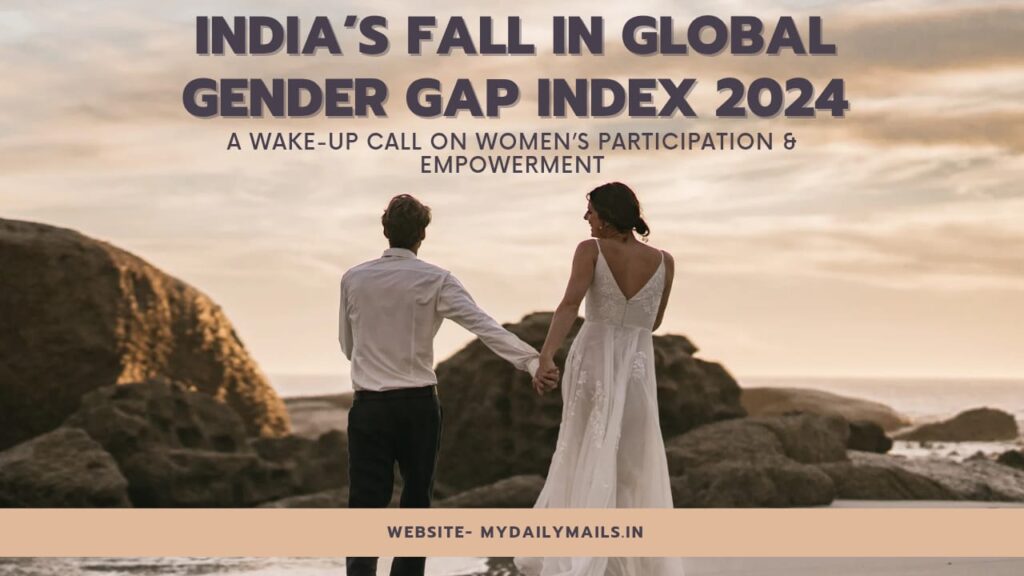
India has recently seen a significant drop in the Global Gender Gap Index 2024, a ranking released annually by the World Economic Forum (WEF). While many overlooked the report, the findings are deeply concerning and demand national introspection. India’s position has slipped from 129th to 131st out of 146 countries, indicating a regression in gender equality despite minor improvements in absolute scores.
What is the Global Gender Gap Index?
The Global Gender Gap Index is a benchmarking tool first launched in 2006 by the World Economic Forum, aiming to measure gender-based disparities across countries. It evaluates nations based on four key dimensions, with each contributing 25% to the total score:
| Dimension | Description |
| Economic Participation and Opportunity | Labor force participation, wage equality, and roles in skilled professions |
| Educational Attainment | Literacy rates and school enrollments from primary to tertiary levels |
| Health and Survival | Sex ratio at birth and life expectancy |
| Political Empowerment | Representation of women in parliament and ministerial positions |
India’s Global Rank and Score
| Year | Rank (out of 146 countries) | Score (%) |
| 2023 | 129 | 63.8 |
| 2024 | 131 | 64.1 |
While India’s score improved slightly from 63.8 to 64.1, other countries outpaced this progress, pushing India down the rankings.
Top Performing Countries in 2024
| Country | Score |
| Iceland | 92.0% |
| Finland | ~88% |
| Norway | ~87% |
| New Zealand | ~85% |
| United Kingdom | ~84% |
India, with a score of 64.1%, lags far behind the global average of 68.8%.
In India vs Neighboring Countries
| Country | Rank |
| Bangladesh | 24 |
| Bhutan | 119 |
| Nepal | 125 |
| Sri Lanka | 130 |
| India | 131 |
| Pakistan | 146 |
India remains ahead of only Pakistan in South Asia, highlighting regional concern for gender disparities.
India’s Performance Across the 4 Dimensions
1. Economic Participation and Opportunity
- Score: 40.6%
- Rank: 144 out of 146
- Concerns:
- Only 45.9% female labor force participation
- Women earn just 30% of what men earn
- Low presence in senior and technical roles
Reasons:
- Predominance of informal economy
- Gender norms and safety issues
- Lack of recognition for unpaid domestic work
2. Educational Attainment
- Score: 97%
- Rank: Top 30 globally
Strengths:
- Strong improvement in literacy rates
- Decline in gender gaps in primary and tertiary enrollments
Challenges:
- High dropout rates in secondary education
- Urban-rural disparities persist
3. Health and Survival
- Score: ~95%
- Rank: Top 60–70 globally
Improvements:
- Sex ratio at birth is gradually improving
- Female life expectancy is rising
Challenges:
- Gender-based sex selection in rural areas
- Maternal health in underserved regions
4. Political Empowerment
- Score: -0.6 (decline)
- Issues:
- Parliamentary representation of women dropped from 14.7% to 13.8%
- Ministerial representation fell from 6.5% to 5.6%
Positives:
- India has had a female President and Prime Minister
Yet, overall political representation remains alarmingly low.
Key Reasons Behind India’s Decline
| Factor | Explanation |
| Poor Economic Participation | Low labor force and pay parity for women |
| Political Underrepresentation | Decline in women leaders in government |
| Relative Stagnation | India’s slow progress compared to others |
| Weak Ground Implementation of Schemes | Schemes like Beti Bachao Beti Padhao underperform at grassroots |
| Cultural Barriers | Patriarchal norms limit women’s freedom and choices |
Implications of Gender Gap on India
1. Social
- Deep-rooted patriarchal values
- Women’s autonomy and safety are compromised
2. Economic
- India loses approximately $770 billion annually due to gender inequality
- Missed GDP growth, innovation, and productivity
3. Political
- Lack of gender diversity in politics weakens inclusive governance
- Diminishes public trust in leadership
What Can Be Done?
Economic Reforms:
- Promote women’s participation in formal workforce
- Offer flexible work options and maternity benefits
- Focus on skill development
Political Reforms:
- Implement 33% women reservation in Parliament
- Encourage party-level gender quotas
Safety and Legal Protections:
- Strengthen anti-harassment laws
- Expand women-led policing and fast-track courts
Cultural Interventions:
- Integrate gender sensitivity into school curricula
- Enhance campaigns like Beti Bachao Beti Padhao
- Introduce gender-based budgeting with accountability
Frequently Asked Questions (FAQ)
Q1. What is the Global Gender Gap Index?
It is an annual report by the World Economic Forum measuring gender disparities in countries based on economy, education, health, and politics.
Q2. Why did India’s rank fall in 2024?
Due to poor economic participation, lower political representation, and slower progress compared to other nations.
Q3. In which area is India performing well?
India shows strong performance in educational attainment, ranking among the top 30 countries globally.
Q4. What are the social consequences of a low gender gap ranking?
Gender inequality harms women’s dignity, autonomy, and safety, reflecting deeply entrenched biases.
Q5. How can India improve its gender gap ranking?
By enhancing economic opportunities, enforcing political representation, improving safety laws, and shifting cultural attitudes.
Final View: India’s drop in the Global Gender Gap Index 2024 isn’t just a statistic—it’s a wake-up call. Empowering women isn’t optional; it’s essential for national progress. Now is the time to act.
Stay with us for further updates.





